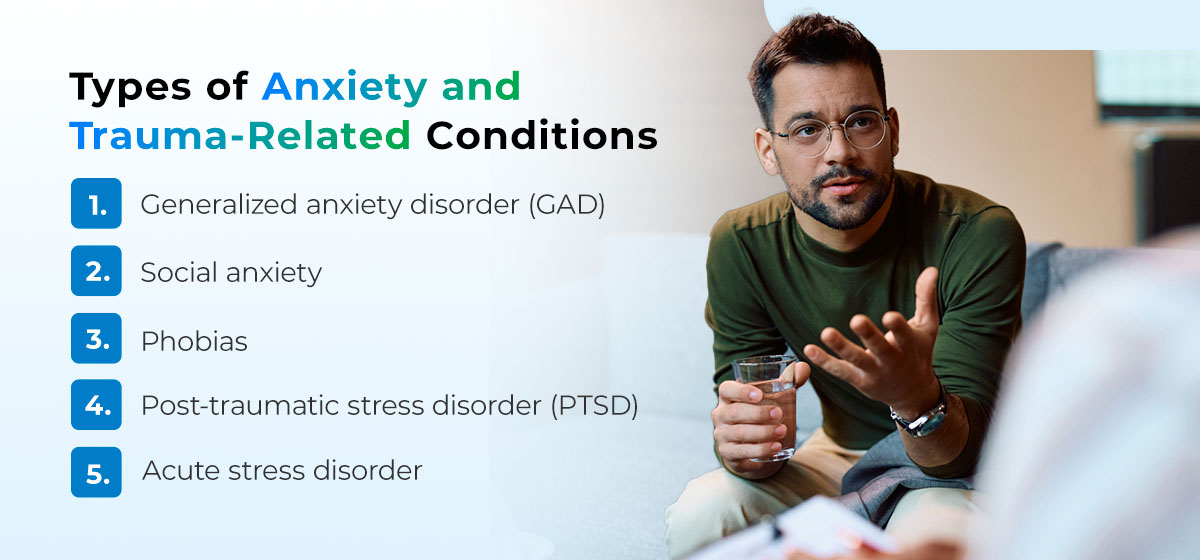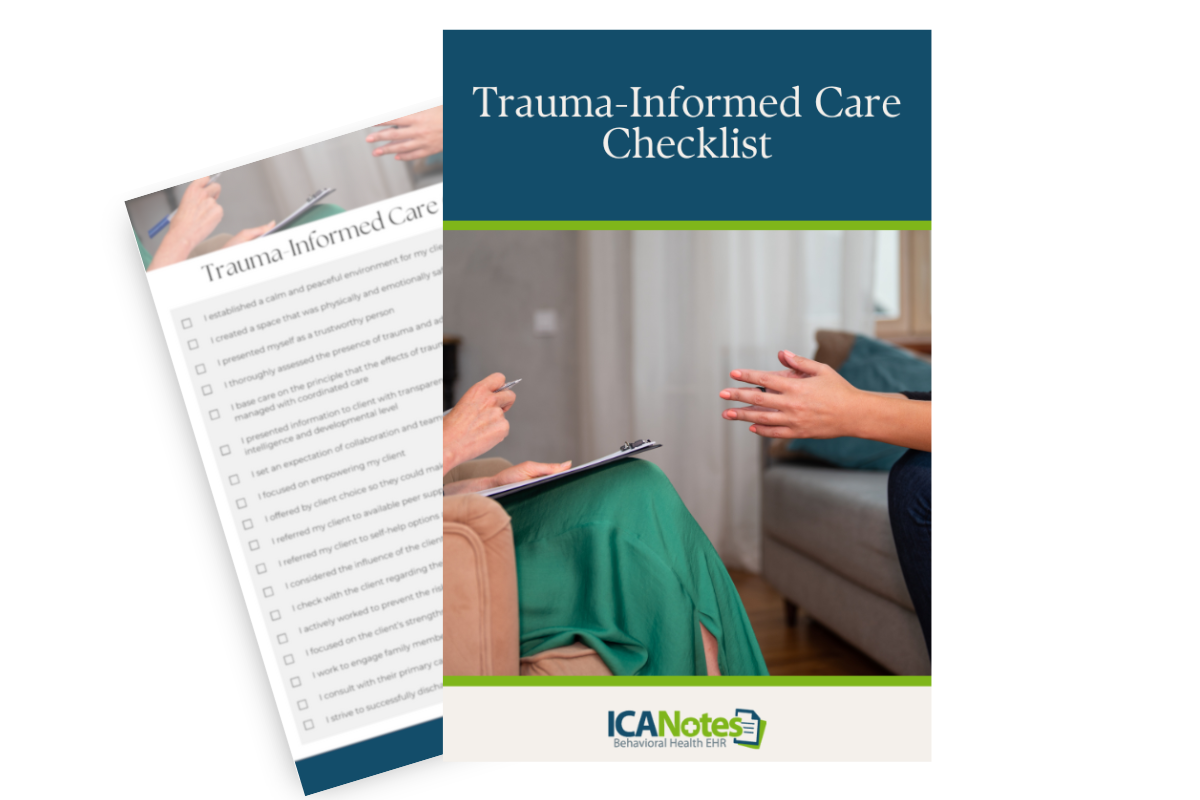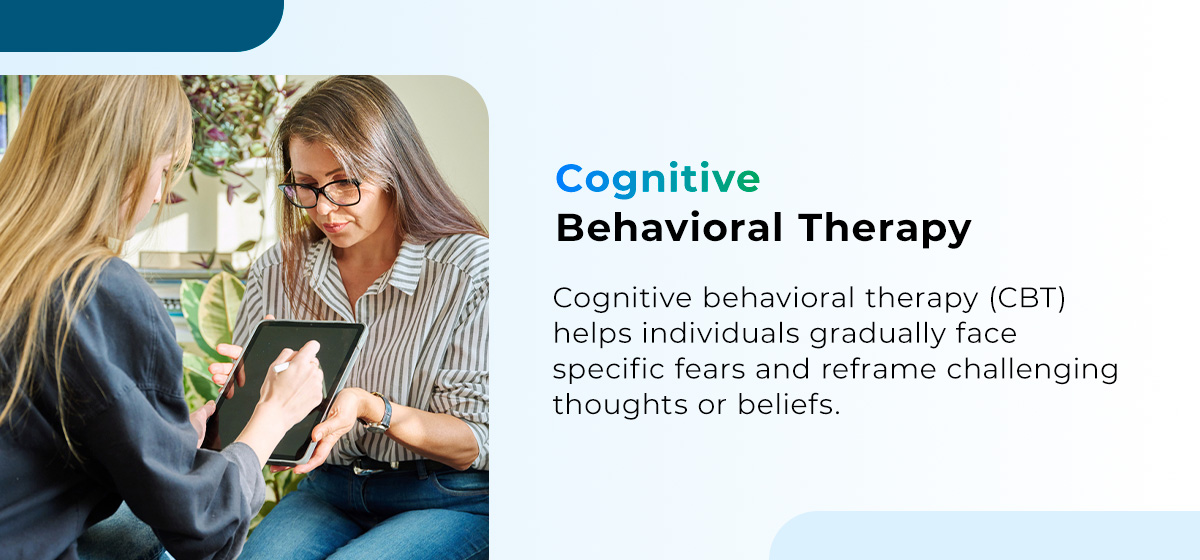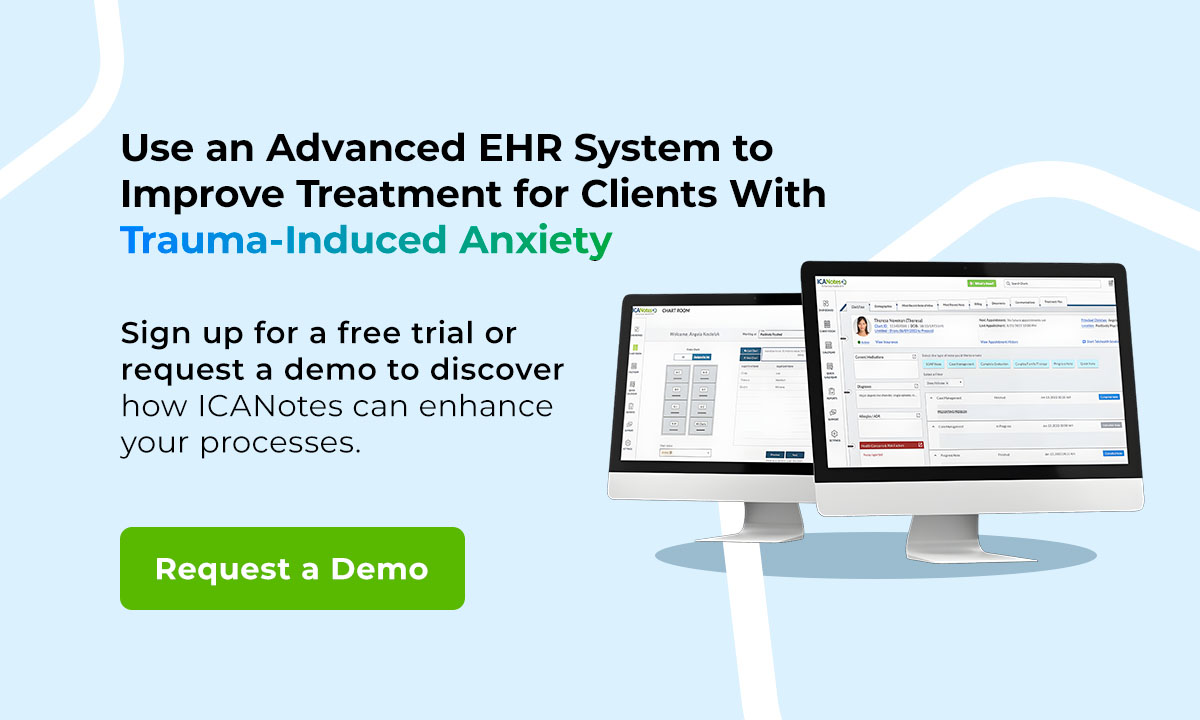Blog > Treatment Strategies > Understanding the Relationship Between Anxiety and Trauma
Understanding the Relationship Between Anxiety and Trauma: How Past Experiences Shape Current Symptoms
Discover how anxiety and trauma intersect, impacting brain function and emotional regulation. Learn trauma-informed strategies to improve client outcomes.

Last Updated: February 18, 2025


What You'll Learn
-
How trauma alters brain function, leading to increased anxiety.
-
Recognizing various anxiety disorders stemming from traumatic events.
-
Implementing trauma-informed care to create supportive therapeutic environments.
-
Exploring effective therapeutic approaches for trauma-related anxiety
It's common for individuals to develop anxiety caused by a traumatic event. Significant experiences can alter the brain's structure and functionality, increasing stress responses and hindering emotional regulation. Treating a trauma-induced anxiety disorder requires special care and attention to a client's past experiences. Trauma-informed care and individualized therapeutic approaches can enhance outcomes for clients experiencing anxiety from trauma.
Can a Traumatic Event Cause Anxiety?
A traumatic event can cause an anxiety disorder because it triggers the natural stress response system. Trauma-induced anxiety may manifest as different types of anxiety, changing the way people react to stressful experiences.
Anxiety and Trauma in the Brain
The reason trauma and anxiety are so intertwined is because of how certain experiences can alter brain activity. A traumatic experience can affect the following regions within the brain:
- Amygdala: The amygdala is in the brain's temporal lobe, and it's involved in detecting danger and processing emotions like rage, anxiety and fear. It acts as the body's threat detector, assessing social cues, facial expressions and body language to respond to potential threats and react appropriately to social situations. A traumatic event can lead to a hyperactive amygdala, increasing hypervigilance and feelings of anxiety. Amygdala responses are unconscious and occur prior to other areas of the brain responding. If it senses a threat, it will respond and send adrenaline throughout the body.
- Prefrontal cortex: The prefrontal cortex is located in the brain's frontal lobe, and it plays a significant role in emotional regulation, decision-making and inhibiting impulsive behaviors. Traumatic events can impair the prefrontal cortex, leading to increased anxiety and challenges regulating emotions during stressful events.
- Hippocampus: The hippocampus controls how people remember events, storing experiences as long-term memories. A traumatic event can change the brain's hippocampal function and structure, leading to flashbacks, increased anxiety and challenges with remembering events accurately.
Fight, Flight, Freeze, and Fawn
The adrenal glands produce a stress hormone known as cortisol, which helps the body respond to stress. When a stressful event occurs, cortisol activates the fight-or-flight response, increasing blood sugar levels and blood pressure so the body has available energy to respond to threats.
Traumatic events can increase cortisol and heighten the fight-or-flight response, causing individuals to feel anxious in nonthreatening situations.
Some individuals may experience freeze or fawn after an unsuccessful fight or flight response. These stress responses do not involve decisive actions — freeze causes an individual to feel stuck in place, while fawn responses hide distress that occurs because of trauma. Signs of a fawn response include over-agreement or trying to be overly helpful.
Types of Anxiety and Trauma-Related Conditions

Traumatic events can lead to the following types of anxiety and trauma-related conditions:
- Generalized anxiety disorder (GAD): Generalized anxiety disorder is characterized by persistent worry about various everyday events and a consistent anticipation of potential dangers. Trauma can lead to GAD because it increases the brain's sense of insecurity and threat.
- Social anxiety: Traumatic experiences like abuse, public humiliation and bullying can lead to social anxiety. A person with social anxiety may report self-consciousness, an intense fear of judgment and a tendency to avoid social situations.
- Phobias: A phobia is an intense fear of a specific situation, object or activity, and it can originate from a traumatic experience.
- Post-traumatic stress disorder (PTSD): Individuals with PTSD often experience heightened anxiety, flashbacks, intrusive thoughts and avoidance behaviors in response to a traumatic event or multiple traumatic events.
- Acute stress disorder: This condition shares diagnostic criteria with PTSD, but individuals with PTSD experience symptoms for longer than one month.
Trauma and Anxiety Symptoms
Traumatic events and anxiety can cause the following symptoms:
- Hypervigilance
- Avoidance
- Increased heart rate
- Sweating
- Shortness of breath
- Mood changes, such as anger and irritability
- Challenges falling or staying asleep
- Intrusive thoughts, memories, flashbacks or nightmares related to a traumatic experience
- Obsessive thoughts about a traumatic experience
- Constant worry about specific situations or potential outcomes
- Difficulty concentrating
Is Anxiety a Trauma Response to Childhood Events?
Early childhood trauma can significantly impact mental health in adulthood. Childhood experiences often shape an individual's perception of security and safety, so even experiences that seem nontraumatic can play a role in anxiety. Examining the following factors related to your client's childhood can reveal more about their anxiety and how to approach it:
- Past family dynamics
- Parenting style
- Early attachment patterns
- Traumatic childhood events
Trauma can also begin in utero. A child's brain development is significantly affected by traumatic experiences during pregnancy and in the first four years of their life.

Are you creating a truly safe and supportive space for your clients? Trauma can shape every aspect of a person’s life—and how you approach care can make all the difference. Download our Trauma-Informed Care Checklist to ensure you’re implementing best practices that foster trust, resilience, and healing in your clients.
Importance of Trauma-Informed Therapy
A growing awareness of trauma and its effect on the brain has made trauma-informed therapy a vital part of client care. While therapists typically have a general knowledge of trauma and how it affects individuals, trauma-informed therapy takes a deeper approach to helping clients heal. Trauma-informed care is essential for addressing the root causes of clients' anxiety and trauma-related challenges.
How to Enhance Your Trauma-Informed Approach
You can take a more trauma-informed approach to your client care and treatment in the following ways:
- Actively educate yourself on how trauma impacts the brain, keeping up with the latest industry research on trauma.
- Invest in professional development and work toward certifications in trauma-informed care.
- Prioritize providing a safe, supportive therapeutic environment.
- Learn how to recognize the signs of trauma in clients.
- Learn how to avoid re-traumatization.
Best Treatment Approaches for Anxiety and Trauma
The following methods are helpful approaches for anxiety and are often beneficial in trauma-informed care.
Cognitive Behavioral Therapy

Cognitive behavioral therapy (CBT) helps individuals gradually face specific fears and reframe challenging thoughts or beliefs. Incorporating CBT into your treatment approach can help clients with anxiety or PTSD develop more helpful and realistic thought patterns. It's an excellent way to empower individuals by helping them change their perceptions and develop beneficial coping mechanisms.
Behavioral experiments are helpful CBT exercises for clients with trauma-related anxiety. If a traumatic event causes negative beliefs about a place, object, situation or activity, you can encourage a client to engage in real-life situations that help test these beliefs. When a client feels ready to try this activity, it can help them shift their assumptions and reduce anxiety in certain situations.
Psychoeducation is another important part of CBT. Educating your clients about how trauma affects the brain and nervous system can help them understand their thoughts, emotions and symptoms better.
Cognitive Processing Therapy
Cognitive processing therapy (CPT) is a type of CBT and an evidence-based treatment for PTSD. It focuses on the challenging thoughts and beliefs that an individual may develop after a traumatic event, focusing on the following areas that may keep individuals stuck in anxious cycles:
- Self-esteem
- Trust
- Safety
- Control or power
- Intimacy
Trauma-Focused Cognitive Behavioral Therapy
Trauma-focused cognitive behavioral therapy (TF-CBT) is a specialized form of CBT that focuses on the specific details of a traumatic event, and it's more common in treating adolescent clients. TF-CBT involves more trauma-sensitive techniques, such as the following:
- Gradual exposure to traumatic memories or reminders
- Emotional regulation strategies
- A greater focus on relaxation techniques
- A more structured approach of stabilization, trauma narration and integration phases
Prolonged Exposure
Prolonged exposure is a type of CBT that focuses on helping individuals gradually confront emotional triggers. Gradually exposing a client to specific stimuli or situations in a safe, controlled environment can help reduce anxiety. This approach helps individuals learn that their triggers are not as threatening as they perceive them to be. You can also use this technique to help individuals reduce flashbacks and panic attacks related to specific triggers.
Eye Movement Desensitization and Reprocessing
Eye movement desensitization and reprocessing (EMDR) therapy helps people reprocess distressing and traumatic experiences. It combines cognitive processing and eye movements to activate bilateral stimulation and reduce stress connected to specific memories. This treatment can help individuals decrease the stress and anxiety they feel about a traumatic memory and similar situations.
Acceptance and Commitment Therapy
Acceptance and commitment therapy (ACT) helps individuals accept their emotions and thoughts. This approach is helpful for individuals who often try to suppress or avoid challenging experiences. Incorporating ACT treatment into a client's care plan can help them accept their emotions as part of their human experience and allow their personal values to direct their actions despite their emotions.
Narrative Therapy
Narrative therapy helps individuals understand their experiences and reframe them for personal growth and healing. The goal of narrative therapy is to help a client closely examine and re-narrate their story so they can separate their identity from traumatic experiences.
Mindfulness-Based Therapies
Mindfulness-based therapeutic techniques like guided meditation, body scan exercises and focused breathing help people learn how to cope with anxiety by shifting their focus to the present moment. Mindfulness therapy is an excellent way to help clients process traumatic experiences because it creates a safe space to approach memories without feeling overwhelmed.
Creative Arts Therapy
Creative arts therapy can include one or all of the following approaches:
- Art activities, such as drawing, painting and sculpture
- Dance and movement
- Writing or journaling
- Music
- Drama
- Poetry
Clients who engage in creative arts therapy may develop a greater sense of self-awareness and self-esteem. This method provides a safe outlet for clients to express emotions, process traumatic memories and learn new coping skills.
Group Therapy
Group therapy can help individuals with PTSD or anxiety conditions feel a sense of connection and belonging. Sharing their experiences and learning from the experiences of others reminds them that they're not alone. Providing group therapy or including group therapy in a client's treatment plan can boost their confidence in managing anxiety.
Medication Management
Some clients may require medication or want to try medication for anxiety management. Before prescribing medication to a client, make sure to:
- Involve the client in the decision-making process.
- Complete a thorough assessment to ensure medication is necessary.
- Inform your client about the potential benefits and side effects.
- Closely monitor medication effectiveness.
- Combine the medication with nonpharmacological therapies.
Tips for Treating Patients with Anxiety and Trauma
Keep the following tips in mind when treating clients with trauma and anxiety.
Use an Individualized Approach
Each person is different and has unique experiences, and their treatment should honor that. Get to know your patient closely, conducting thorough assessments and asking them about their preferences. Tailor each treatment plan to the client's specific needs.
Build Trust
Building trust helps clients feel comfortable opening up, so it's important to do the following in each session:
- Practice active listening.
- Demonstrate empathy by validating emotions.
- Maintain a neutral tone.
- Set and maintain clear boundaries.
- Use clear, respectful language.
- Be transparent about the therapy process, potential outcomes and potential challenges.
Maintain Gradual Exposure
Gradual exposure is vital for helping clients confront challenging situations at a manageable pace. Use the following strategies to maintain a comfortable pace for your client:

- Help your client create a personalized fear hierarchy listing anxiety triggers in order from least provoking to most provoking.
- Closely monitor discomfort or tension levels.
- Allow the client to adjust or pause exposure when necessary.
- Provide support throughout the process.
Keep Detailed Records
Detailed clinical notes are vital when treating clients with anxiety and past traumatic experiences. Maintain a comprehensive record of each client's symptoms, experiences, emotional triggers and treatment progress so you can:
- Individualize treatment plans effectively.
- Monitor the effectiveness of treatment methods for each client.
- Identify potential challenges.
- Maintain continuity of care.
Why Trust ICANotes With Your Documentation Needs?
Consistent, detailed notes can help you tailor treatment plans and track progress for clients with trauma and anxiety. ICANotes is the mental health industry's premier electronic health record (EHR) software, providing a streamlined way for you to record clinical notes.
At ICANotes, we developed a comprehensive, behavioral-health-specific solution to help you simplify documentation processes and spend more time with clients. As the only EHR designed by clinical psychiatrists, ICANotes is tailored for mental health clinicians and offers the following advantages:
- Easy navigation: A user-friendly interface simplifies navigation, making it easier to manage your practice.
- Customization: Our experts designed ICANotes to work specifically for you and the way you think. Thousands of preformatted, customizable templates enable you to create individualized clinical reports and notes via point-and-click functionality.
- Increased revenue: ICANotes automatically identifies the highest billable coding level based on your notes to help you maximize revenue.
- Remote access: You can access ICANotes and work on client records from any smartphone or computer with an internet connection.
- Compliance: Our frequently updated EHR solution meets stringent industry standards and helps you avoid medical legal liability.
- Unlimited support: At ICANotes, we provide one-on-one training and unlimited support to ensure smooth processes.
- More time: Spend less time on documentation and more time on professional development, client sessions and treatment plans. ICANotes reduces the time you need to spend on charting and documentation.
Use an Advanced EHR System to Improve Treatment for Clients With Trauma-Induced Anxiety
Clients who experience anxiety due to trauma require specialized treatment for healing. Trauma-informed therapies, individualized treatment plans and detailed clinical notes can help you effectively support your clients. ICANotes offers a comprehensive EHR system to simplify your note-writing and documentation process, helping you maintain accurate records and have more time to spend on client care.
ICANotes is the industry's most trusted EHR program because it's designed by professional mental health clinicians. This robust system streamlines your practice's entire workflow, making it easier to manage communication, scheduling, billing, assessments and treatment. Sign up for a free trial or request a demo to discover how ICANotes can enhance your processes and help you better support clients with anxiety.
Get Your Free 30-Day Trial (no credit card required!)
Related Posts
Sara Blevins-Ranes, MA, LPC, ATR, graduated with her BA in Art Therapy and Psychology from Converse University and with her MA in Art Therapy from The George Washington University. Located in Texas, Sara is a trauma-informed clinician who specializes in child and adolescent crisis care and has experience with active duty and veteran populations, school-based therapy, as well as within hospice care for children and adults.







